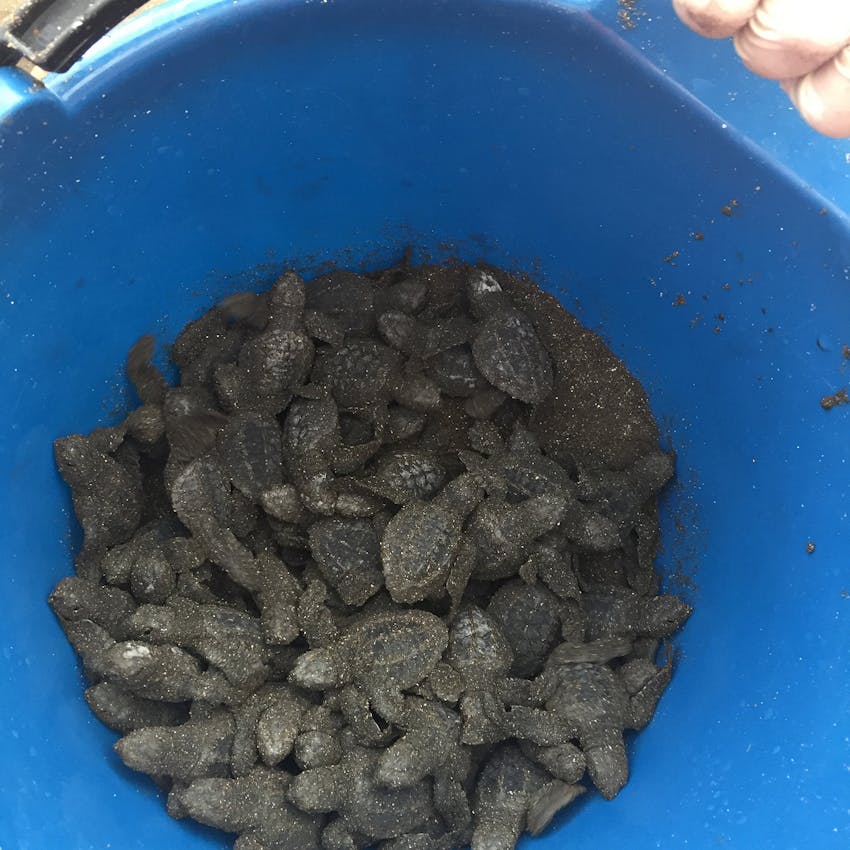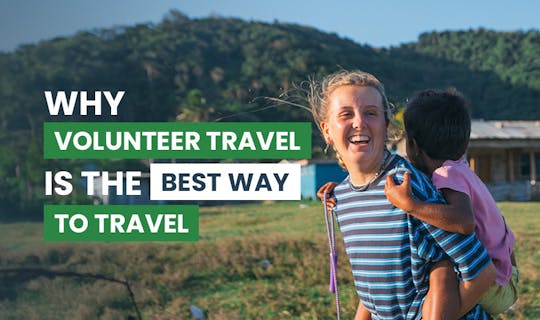
Here’s what to expect on a Turtle Conservation volunteer project with International Volunteer HQ: Meg Stewart and her daughter Tillie recently joined us in Costa Rica and they’ve decided to share their experience…
My daughter and I wanted to do an international volunteer project together this summer. I am a teacher and I have summers off and my daughter is 16 years-old so couldn’t go on one of these volunteer programs alone. She is fluent in Spanish so I was set on going to a Spanish-speaking country. We looked at all sorts of volunteer organizations and kept coming back to IVHQ, with the primary reason being a wealth of well-made videos showing what projects are available and what we might want to do. We decided on turtle conservation in Costa Rica.

My Concerns Going Into This: Is International Volunteering Just for Gap Year Students?
Before leaving for our trip, we researched as much as we could. Including the possible locations we could be sent to within Costa Rica. All seemed great, for one reason or another. So wherever we were asked to volunteer would be fine with us. Drawbacks were that it would be too hot, very buggy and possibly quite rainy. We came prepared for all of the above. However, my primary concern, was that I would be the oldest person at the site. And my second concern was that my daughter might feel uncomfortable with being the youngest and the only one there with her mom. I didn’t see any testimonials from families nor did I see any videos or social media about family groups going to volunteer, I just saw millennials going abroad and doing their thing and having a blast while doing good work. Of my first concern, I was right; at age 55 years old, I was the oldest volunteer at the site, but that didn’t matter so much because my second concern was alleviated by the fact that there were two other family units at the site, with the youngest children being 8 and 17 years old. There were even several other teenagers at the site, so before even stepping foot into the turtle conservation arena, I felt comfortable. And so did my daughter.

What Does Sea Turtle Conservation Look Like?
There were twelve volunteers sent to Playa Junquillal to work with the turtle conservation group, who have been working with the sea turtles and local educational initiatives since 2007. The head of the organization is Val and she showed us around right away. We volunteers included the three families, two 30-something teachers who went for similar reasons that I did, and two 20-something young people, the age that I thought the whole crew was going to be! Boy, was I way off with my expectations. Once we arrived in Junquillal, we got settled into dorm rooms. Those dorms were like camp bunks and they were how we were teamed up for night patrols and day activities. Two huge electric fans kept us cool at night.

The day we first arrived to Junquillal, there were sea turtle hatchlings that came up out of their nest in the hatchery. This was very exciting and there was a great show of it. We all lined up behind a line drawn in the sand and Val placed a baby turtle in our hands. There were also about 20 or so tourists there. We placed the babies at the line and then they “raced” to the ocean. There were about 90 hatchlings in total so we all got to place a couple of little turtles down onto the sand. Actually, this part of turtle conservation is important. Baby turtles need to walk on the sand to get their lungs functioning properly. They also need to imprint the sand on to themselves as they take the walk into the Big Blue because the females will return to this same beach when they are at nesting age and knowing the sand is what brings them back. And finally, another critical reason to have a controlled release of the babies is that there are no predators lurking about - dogs, vultures, sea gulls and pelicans - all of whom would love a little turtle snack. It was an exciting start to our sea turtle conservation project, for sure.

Turtle patrols happen every night, and usually there are two shifts. Nesting sea turtles do not nest during the day and wait to come up to the shore after sundown. They try to finish their laying before the sun comes back up. A turtle patrol happens, then, in total darkness save for the light of the moon. You cannot use a flashlight because any light will startle the turtle and she will not come ashore. And of course, I didn’t take any pictures because of the bright light prohibition. Soon, your eyes adjust and you get your night vision working. The lead patrol person - either Val, or Pan, or Joss - will carry a red-light flashlight for times of truly needing to see tracks or a turtle but these people really have top-rate night vision. While on beach patrols, we walk a total of about 12 km and this usually takes three hours or longer. We do take breaks, but it can be tiring walking in sand. It is also hot and muggy out, even at night and even by the sea. The reasons we do these organized beach patrols are 1) look for turtle tracks and nests or nesting turtles making their way to shore in order to relocate the eggs, and 2) discourage poachers who would like to take the eggs to eat or sell; some poachers do take the adult turtles to eat. We did not see any poachers and, with educational programs in place all along the beaches of San Jose, egg and turtle poaching, thank goodness, is rare.
While on patrol, once we see turtle tracks we then must find the turtle’s nest and dig up the 100 or so eggs. We count them, take notes on the time of night, the moon phase, and the location along the beach. What was nice for me to see, as a science teacher, is this is research being collected that goes into a larger, worldwide conservation database on sea turtle nesting habits. Once we have gently placed the eggs into a large bag, we make our way back to the hatchery where we dig out a designated space to place the eggs. The eggs are now safe from poachers, crabs, birds, and dogs for the duration of the gestation period, which is about 60 days. Once the hatchlings come up, we count the number of living turtles before setting them off to their run to the ocean. For a variety of reasons some eggs do not hatch and all of that information goes into the sea turtle database.
Though we had a three hour beach patrol night shift, we also had daytime activities. Some of the work that we engaged with included freshening up the sand in the hatchery, general beach cleanup walks on Junquillal, repairing nest baskets - these keep the pesky crabs out of the incubating nest, and beach reforestation efforts where we planted native trees or pruned and weeded around trees for greater growth. The trees are important to supply shade or privacy to the nesting turtles as well as shade for the nests.
Would We Volunteer Again? Absolutely!
My daughter and I chose turtle conservation as a volunteer project because we were already quite familiar with marine turtles having lived in Trinidad for six months (leatherbacks nest there) and Barbados for a year (hawksbills and green turtles came up regularly on the beach near our house there). We thought we could contribute, because we already knew some things about the nature of sea turtles. One thing I didn’t realize was just how much we would learn by volunteering at the center. From the first moment we arrived at this remote, sleepy and stunning beach location, all the volunteers were immersed into an education on sea turtle conservation. We were shown, by example, how to handle the baby turtles, why the conservation program is so important, what we would be doing and why we would be doing it. The tasks we were asked to do were not easy and required either stamina, dexterity or patience. My daughter said to me after about four days in Junquillal, “I love doing this project! It’s the real deal. What we’re doing is really helping them with the turtles.” And I agree. In a short period of time, the volunteers are up-to-speed on the tasks because we are thrown into the project with our hands first.
While on our downtime, there are plenty of ways to relax. For one thing, Junquillal beach is a short three minute walk down a quiet dirt road. The hard, flat sand was perfect for running on. There are hammocks to lie in - that’s where I could always find my daughter. There were always a few friendly dogs wandering in and out too. One dog, a big Rottweiler named Keara, would go out on beach patrol with us. Wildlife there was fascinating and different from my usually deer, sparrows, and squirrels in New York. One day when the dogs got to barking about something, we heard the amazing sound of Howler monkeys in the trees above us. I didn’t even know we would see monkeys, but there they were - a family of monkeys. In the coconut trees next to the hatchery, squawking green parrots came home to roost every evening. We saw iguanas, toads, geckos and heard many varieties of birds. Oh, and the people that we met along the way were wonderful, always friendly and relaxed. Pura vida!

Visit our Volunteer in Costa Rica page to learn more about the awesome volunteer opportunities in Costa Rica, or explore IVHQ’s Turtle Conservation volunteer projects in Bali and Guatemala.

